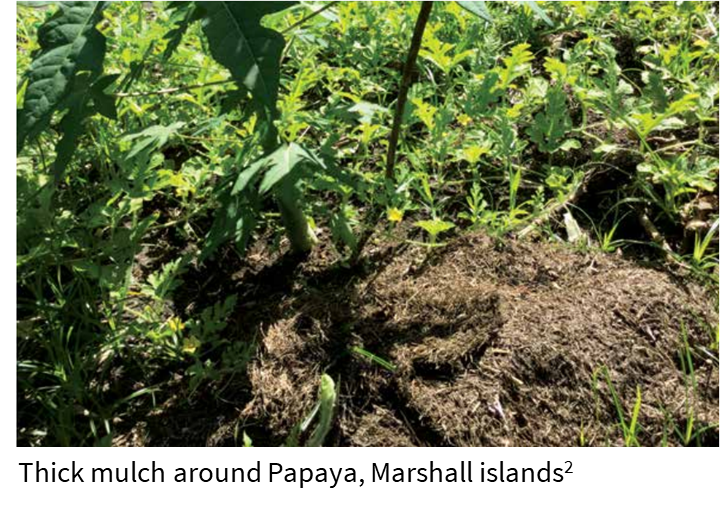Overuse of natural resources (land and water) and increasing use of unsustainable agriculture practices have degraded soil and water resources across the Pacific. Deforestation and inappropriate agricultural practices on sloping lands can lead to soil erosion by loss of soil organic carbon, declining soil physical properties and loss of plant nutrients. This impacts soil fertility and crop productivity.
Soil conservation technologies/practices aim to reduce soil erosion and minimise the adverse impacts of agriculture on natural resources. Along with water conservation approaches, it helps to reduce the impacts of drought on production of crops, lives and livelihood. Conservation of soil and water resources are important for sustaining the environment and agriculture. ![]()
Example soil conservation practices include:
- Contouring /terrace farming
- Cover crops and conservation
- Mulching
- Residue management
- Plantation of windbreaks
- Plantation of native species to support biodiversity.
Example water conservation practices include:
 Infiltration ditches
Infiltration ditches- Earthen check dams
- Revegetating the catchment
- Restoring riverbank vegetation.
Soil and water conservation technologies/practices implementation is low cost as it only requires human resources (e.g. planting, maintenance) and low cost materials (e.g. plants). Whilst providing cost estimates is difficult given the broad range of influencing factors across the Pacific, the below table outlines the key components that should be taken into account when estimating a soil and water conservation technologies project budget for a specific location.
|
|
|
|
|
|
|
|
||||
|
|
|
|||
|
|
|
|||
|
|
|
|||
|
|
|
|||
|
|
|
|||
|
|
|
|||
|
|
||||
|
|
|
|||
|
|
|
Soil and Water Conservation practices are compared against conventional farming approaches adopting inefficient irrigation practices and high use of fertilizers and pesticides. Comparisons between the approaches include:
- Improved soil fertility and water availability through the use of water and soil conservation approaches can increase agricultural output in the longer term.
- Water and soil conservation approaches decrease the need for expensive irrigation water supply and storage systems.
- -
Ecosystem-based adaptation in marine ecosystems of tropical Oceania in response to climate change. See https://www.researchgate.net/publication/234077035_Ecosystem-based_adaptation_in_marine_ecosystems_of_tropical_Oceania_in_response_to_climate_change
- -
Mainstreaming ecosystem services and biodiversity into agricultural production and management in the pacific islands. See https://www.fao.org/3/i6505e/i6505e.pdf
- -
1,2. Mainstreaming ecosystem services and biodiversity into agricultural production and management in the pacific islands. See https://www.fao.org/3/i6505e/i6505e.pdf
Case study
Slash and Mulch method for retaining Soil organic matter
Slash and Mulch is a soil and water conservation practice that enhances soil organic matter and increases nutrients in the soil. A mulch crop or slash crop is grown and then it is slashed to create a deep mulch bed for planting. In Papua New Guinea, before planting taro, the stem of trees within the farming area is ringbarked. Ringbarking causes the leaves of the trees to drop on the ground, providing mulch to where the taro is then planted. In the Solomon Islands, trees are cut and used as a mulch for yams plantation. The mulch provided by the trees and leaves minimizes soil water losses and provides a cool environment for soil biological activity. The thick covering on the soil also acts as a physical barrier and curbs weed emergence.
Reference: Mainstreaming ecosystem services and biodiversity into agricultural production and management in the pacific islands, https://www.fao.org/3/i6505e/i6505e.pdf
